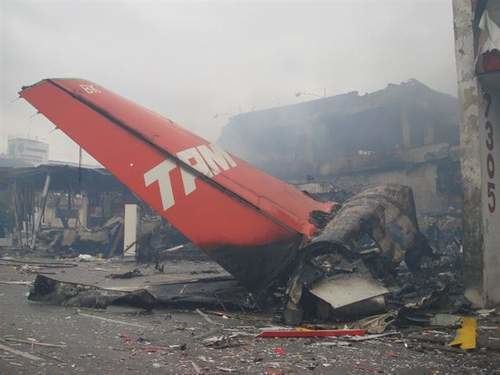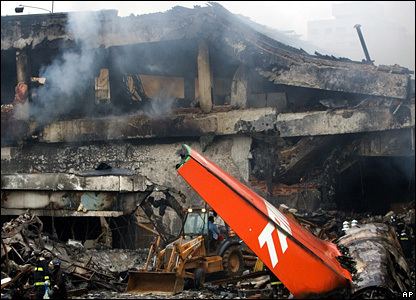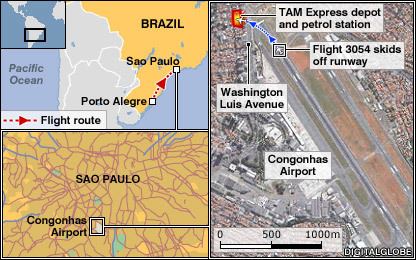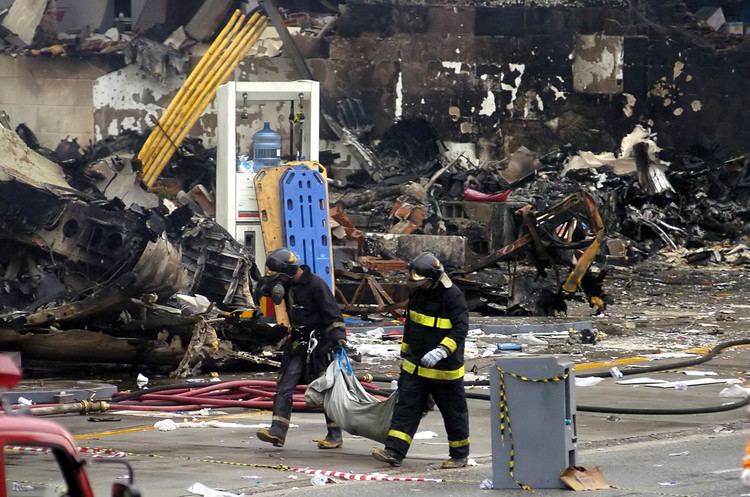Passengers 181 Aircraft type Airbus A320-233 Date 17 July 2007 Survivor 0 Crew count 6 | Survivors 0 Registration PR-MBK Operator LATAM Brasil Passenger count 181 | |
 | ||
Fatalities 199 (all 187 on board; 12 on the ground) Similar Gol Transportes Aéreos Fl, TAM Transportes Aéreos R, Air France Flight 358, West Caribbean Airways F, American Airlines Flight 1420 | ||
TAM Airlines Flight 3054 (JJ3054/TAM3054) was an Airbus A320-233, registration PR-MBK, on a scheduled domestic passenger flight from Porto Alegre to São Paulo, Brazil. On July 17, 2007, the Airbus A320 overran runway 35L at São Paulo during moderate rain and crashed into a nearby TAM Express warehouse adjacent to a Shell filling station. All 187 passengers and crew aboard the Airbus A320 died, along with 12 people on the ground. It surpassed Gol Transportes Aéreos Flight 1907 as the deadliest air disaster in Brazilian territory, and remains the deadliest aviation accident involving an Airbus A320 proper worldwide. It was also the deadliest accident involving an aircraft of the A320 family at the time, which was later surpassed by the bombing of Metrojet Flight 9268, an A321-231, which crashed in Egypt in October 2015 with 224 fatalities.
Contents
- Air crash investigations mayday 11x01 deadly reputation tam airlines flight 3054
- Aircraft and crew
- Flight chronology
- Crash
- Congonhas
- Aftermath
- Investigation
- Final report
- Response
- Legal action
- Notable victims
- Dramatization
- References

The accident was investigated by the Brazilian Air Force's Aeronautical Accidents Investigation and Prevention Center (Portuguese: Centro de Investigação e Prevenção de Acidentes Aeronáuticos (CENIPA)), with a final report issued in September 2009. CENIPA concluded that the accident was caused by errors committed by the pilots on the flight to São Paulo.

Air crash investigations mayday 11x01 deadly reputation tam airlines flight 3054
Aircraft and crew

The aircraft serving Flight 3054 was an Airbus A320-233, serial number 789, registration PR-MBK, powered by two IAE V2500-533 engines. It was built in February 1998 and first entered service in March flying for TACA Peru as N454TA, later serving in the fleet of Pacific Airlines as VN-A168. The aircraft was owned by Pegasus Aviation before entering service with TAM in January 2007. As of April 20, 2007, the aircraft had flown almost 21,000 hours over 10,000 cycles.

The aircraft was dispatched with the thrust reverser (a mechanical device to help slow the airplane down on landing) on the number 2 (right-side) engine deactivated, as it had jammed. TAM said in a statement that a fault in a reverser "does not jeopardize landings", and that no mechanical problem had been recorded on July 16, the day before the accident. It was reported that the aircraft had no difficulty braking on the same runway a day before the fatal accident. The deactivated thrust reverser on the number 2 engine was confirmed by Airbus on July 25.

The flight was under the command of an experienced cockpit crew, consisting of Captain Kleyber Aguiar Lima (53) and Co-Pilot Henrique Stephanini di Sacco (54). Both pilots had been flying for over 30 years. The captain had accrued nearly 13,700 flight hours throughout his career and the co-pilot had almost 14,800 hours of flying experience.
Flight chronology

The plane departed from Salgado Filho International Airport in Porto Alegre at 17:16 local time (20:16 UTC). At 18:50 local time (21:50 UTC), the flight made its landing at Congonhas-São Paulo Airport.
Crash
Flight 3054 was cleared to land at Congonhas' 35L runway. Reviews by government officials of the surveillance videos showed that despite the aircraft touching down at the normal touch-down point on the runway, it did not slow down normally, crossing the far end of the runway at around 90 knots (170 km/h). The aircraft, bearing to the left, continued off the end of the runway. The runway is elevated above the surrounding area, and the aircraft's momentum carried it over the traffic on the adjacent Avenida Washington Luís, a major thoroughfare. After clearing the road, the aircraft exploded on impact with a four-story TAM Express facility, resulting in a large fire, and killing everybody on board instantly. The TAM Express building contained offices and a warehouse, and was located adjacent to a Shell gas station.
The runway had recently been resurfaced, but it did not yet have water-channeling grooves cut into it to reduce the danger of hydroplaning.
Flight Data Recorder (FDR) information recovered after the crash and released by Brazilian authorities showed that immediately prior to touchdown, both thrust levers were in CL (or "climb") position, with engine power being governed by the flight computer's autothrottle system. Two seconds prior to touchdown, an aural warning, "retard, retard," was issued by the flight's computer system, advising the pilots to "retard" the thrust lever to the recommended idle or reverse thrust lever position. This would disengage the aircraft's autothrottle system, with engine power then being governed directly by the thrust lever's position.
At the moment of touchdown, the spoiler lever was in the "ARMED" position. According to the system logic of the A320's flight controls, in order for the spoilers to automatically deploy upon touchdown not only must the spoiler lever be in the "ARMED" position, but both thrust levers must be at or close to the "idle" position. The FDR transcript shows that immediately after the warning, the flight computer recorded the left thrust lever being retarded to the rear-most position, activating the thrust reverser on the left engine, while the right thrust lever (controlling the engine with the disabled thrust reverser) remained in the CL position. One theory put forth by CENIPA is that the pilots may not have noticed that the right engine remained at CL because the Airbus autothrottle system, unlike other aircraft manufacturers, does not automatically move the levers when the autothrust controller changes engine settings. Therefore, the pilots may have thought that the right engine was at idle power without realizing that Airbus autothrust logic dictates that, when one or more of the thrust levers is pulled to the idle position, the autothrust is automatically disengaged. Thus, when the pilot pulled the left engine thrust lever to idle, it disconnected the autothrust system and the computer did not retard the right engine power to idle. The A320's spoilers did not deploy during the landing run, as the right thrust lever was above the "idle" setting required for automatic spoiler deployment. Since the right engine thrust lever was still in the "climb" detent at that time, the right engine accelerated to climb power while the left engine deployed its thrust reverser. The resulting asymmetric thrust condition resulted in a loss of control and a crash ensued.
Congonhas
Aviation safety in Brazil had been under increased scrutiny following the mid-air collision in September 2006 over the Amazon of Gol Transportes Aéreos Flight 1907 and an Embraer Legacy 600 (see Brazil's 2006-2007 aviation crisis). Congonhas was singled out for having safety issues relating to operations in wet weather due to its location and runway characteristics for the traffic it serves.
The 35L runway at Congonhas is 1,940 metres (6,360 ft) long. Congonhas' counterpart in Rio de Janeiro, the Santos Dumont Airport, has an even shorter runway, at 1,323 m (4,341 ft). Both airports receive the same type of traffic — ranging from small private planes to Boeing 737s and A320s. Many variables affect the landing distance of an aircraft, such as approach speed, weight and the presence of either a tailwind or a headwind. For an Airbus A320, a speed of just 20 knots (37 km/h) higher than normal can result in as much as a 25% increase in the runway length needed to stop an aircraft. Wet weather can also significantly reduce the braking performance of aircraft, leading to an increase in the minimum runway length requirement.
Pilots have called Congonhas airport the "aircraft carrier," because of the runway's short length and because pilots are told to go-around if they overshoot the first 1,000 feet (300 m) of runway.
In February 2007, a Brazilian judge briefly banned flights using Fokker 100, Boeing 737-700 and Boeing 737-800 aircraft in and out of the airport. The Airbus A320 was not among the aircraft banned, due to its manufacturer-stated braking distance being shorter than those of the banned aircraft. Pilots had complained that water had been accumulating on the runway, reducing aircraft braking performance and occasionally causing planes to hydroplane. The judge claimed the runway needed to be 388 metres (1,273 ft) longer for these aircraft to operate safely. At the time, a spokeswoman from Brazil's National Civil Aviation Agency claimed "The safety conditions of the runway and the airport as a whole are adequate." TAM also objected to the decision, with a spokesman stating "If the injunction stands, it will cause total chaos," claiming over 10,000 passengers per day would be inconvenienced. The airport authorities appealed the decision, resulting in it being overturned the following day. An appeals court overruled the ban on the three types of planes, saying it was too harsh as it would have severe economic ramifications and that there were not enough safety concerns to prevent the planes from landing and taking off from the airport. "The runway was reopened because of popular pressure," Gianfranco Beting, an aviation consultant, said in a TV interview.
Aftermath
The airport reopened on July 19, 2007 using an alternative runway.
Many flights, including all OceanAir and BRA Transportes Aéreos, were transferred to Guarulhos International Airport, the major airport in São Paulo, due to the closure of the main runway at Congonhas and the ongoing investigation of the accident.
On July 20, Presidency Chief of Staff Dilma Rousseff announced plans to significantly reduce the number of flights operating at Congonhas. The plan included banning, within 60 days, all connection, stopover, charter, and international flights and the reduction in the number of private jets. The airport would only operate direct flights to certain cities in Brazil. The plan also called for a study of the expansion of São Paulo's two current airports and the construction of a third airport in the metropolitan area.
State crime scene investigators terminated the search for remains on July 28, 2007; as of that date, 114 bodies recovered from the site had been identified by the São Paulo Medical Examiner's Office as those of passengers.
Investigation
The investigation was carried out by Brazil's Aeronautical Accidents Investigation and Prevention Center (Centro de Investigação e Prevenção de Acidentes Aeronáuticos, CENIPA). Data from the flight data recorder and cockpit voice recorder (CVR) were downloaded by the National Transportation Safety Board in the United States commencing July 20 and 23 respectively. Based on preliminary data from the FDR, on July 25 Airbus cautioned A320 operators to ensure that both thrust levers are set to idle during flare. The transcript of the CVR was released on August 1. It shows that the pilots were aware of the wet runway conditions and the deactivated thrust reverser. The pilots' comments suggest that the spoilers did not deploy and that they were unable to slow the aircraft. Crew error has not been ruled out.
An investigation by the Brazilian Public Safety Ministry released in November 2008 concluded that the pilots mistakenly left the lever for the right engine to climb upon landing, due to a mistake in landing procedures with the right thrust reverser being disabled from a prior maintenance, when in fact it was necessary to retard both engines in order for the spoilers to work. They also said that the National Civil Aviation Agency should have closed the airport on the night the plane landed because of heavy rains; that Congonhas airport authorities shared the blame because its runway had not been properly constructed with grooves to drain away excess rainwater, contributing to the crash; that the plane's manufacturer, Airbus, should have provided alarms warning the pilots that the braking system was failing; and that TAM failed to properly train its pilots, who did not act correctly in the emergency.
Final report
In September 2009, more than two years after the accident, CENIPA announced the results of official investigations. The report shows that one of the thrust levers, which control engines, was in position to accelerate when it should be in idle, but it was not proved if there was mechanical or human failure as the cause of the accident.
The report suggests two hypotheses for the accident. In the first, there was a flaw in the power control of the plane's engines, which would have kept one of the thrust levers into acceleration, regardless of their actual position. In such circumstances, there was mechanical failure of the aircraft. However, the occurrence of this failure is one in 400 billion hours of flight and therefore highly improbable. In the second hypothesis, the pilot has performed a procedure different from that provided in the manual, and put the thrust lever in an irregular position, a configuration of human error for the accident.
In addition to the positions of the thrust levers, the report points to several factors that may have contributed to the accident, such as a high volume of rain on the day, with the formation of puddles on the runway, as well as the absence of grooving. The report does not blame the length of the runway for the accident. The BEA also cleared Airbus of any misdoing because they had proposed a system warning modification regarding the incorrect thrust lever positions which TAM had rejected.
Response
After the crash, President Luiz Inácio Lula da Silva ordered three days of national mourning.
During the 2007 Pan American Games in Rio de Janeiro, the Brazilian athletes wore a black armband in remembrance of the victims. The flags of all participating countries were flown at half mast on July 18. Matches involving a Brazilian athlete or team started with a minute of silence.
All matches of the Campeonato Brasileiro 2007 started with a minute of silence, while all players wore black armbands. Brazilian Formula One driver Felipe Massa had a black stripe on top of his helmet during the 2007 European Grand Prix, to commemorate the victims. Rubens Barrichello also had stripes on his helmet, and the two Red Bull Racing drivers David Coulthard and Mark Webber had small Brazilian flags on their helmets referring to the accident.
More than 5,000 Brazilians marched to the crash site on July 29, 2007, blaming their government's failure to invest in airport infrastructure for the crash. Many of the protesters also demanded the ousting of President Luiz Inacio Lula da Silva.
Legal action
On November 19, 2008, the police investigation was completed using 13,600 pages, which took 16 months of research to be produced, during which 336 people were heard. For federal prosecutors, the former director of ANAC Denise Abreu and then flight safety officer of the company, Marco Aurelio dos Santos de Miranda, should be convicted of attempt on air transport security in willful mode. In March 2006, Denise Abreu took over the management of air services of the newly established National Civil Aviation Agency (ANAC). The investigation of the accident with the Airbus TAM, which killed 199 people in Congonhas, revealed that in February 2007, the São Paulo federal judge Cecilia Marcondes, who saw action restricting the landing planes in Congonhas on rainy days, received Denise Abreu one of ANAC document like a standard, but it was only a technical study. According to the complaint, the study presented as standard guarantee, in theory, security in landing operations at Congonhas airport in São Paulo. The study indicated that takeoffs and landings were forbidden in Congonhas case the track was with a water depth greater than 3 mm. After the accident with the plane of TAM in July 2007 it revealed that the study was not a standard and thus there was no obligation to follow it. According to the testimony of federal judge Cecilia Marcondes to the Federal Public Ministry, the document was fundamental to the Federal Court to release the runway for takeoffs and landings of all equipment.
In 2011, the Brazilian Federal Public Ministry (Ministério Público Federal—MPF) laid criminal charges against Denise Abreu, the director of the Brazilian National Civil Aviation Agency (ANAC) at the time of the disaster, as well as two former TAM directors—Marco Aurélio dos Santos de Miranda, director of flight safety, and Alberto Fajerman, vice president of operations. They were accused of neglecting air transport safety by allowing the aircraft to land in heavy rain on the notoriously short recently resurfaced runway before cutting of grooves to channel away excess rainwater. The trial began in São Paulo in 2013. In 2014, MPF withdrew the charges against Fajerman, for lack of evidence. A second charge against Abreu of "documentary falsehood" was dismissed in November, 2014. As of March 2015, no judgement had been handed down on the other charges.
In 2014, TAM's insurer Itaú Seguros, the company responsible for paying compensation for the tragedy, launched a lawsuit in Brazil against Airbus for R$350 million (US$156.2 million), according to Folha de S. Paulo. Attorneys representing Airbus responded in a Brazilian court filing that Airbus accepts no responsibility, laying the blame for the disaster with the cockpit crew, the airline and the poor state of the runway.
Notable victims
Among the victims were:
Dramatization
Mayday (Also known as Air Crash Investigation in the UK, Australia, New Zealand and Asia and Air Emergency or Air Disasters in the United States) produced a one-hour docudrama about the crash. The episode was entitled "Deadly Reputation" due to the poor reputation the airport (and specifically the runway) has among pilots.
